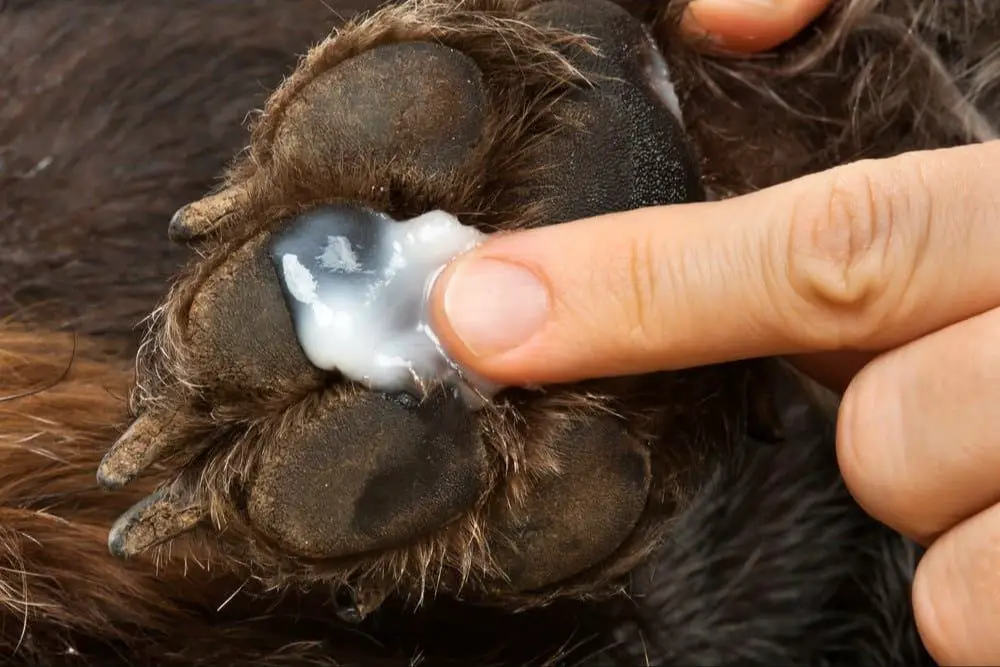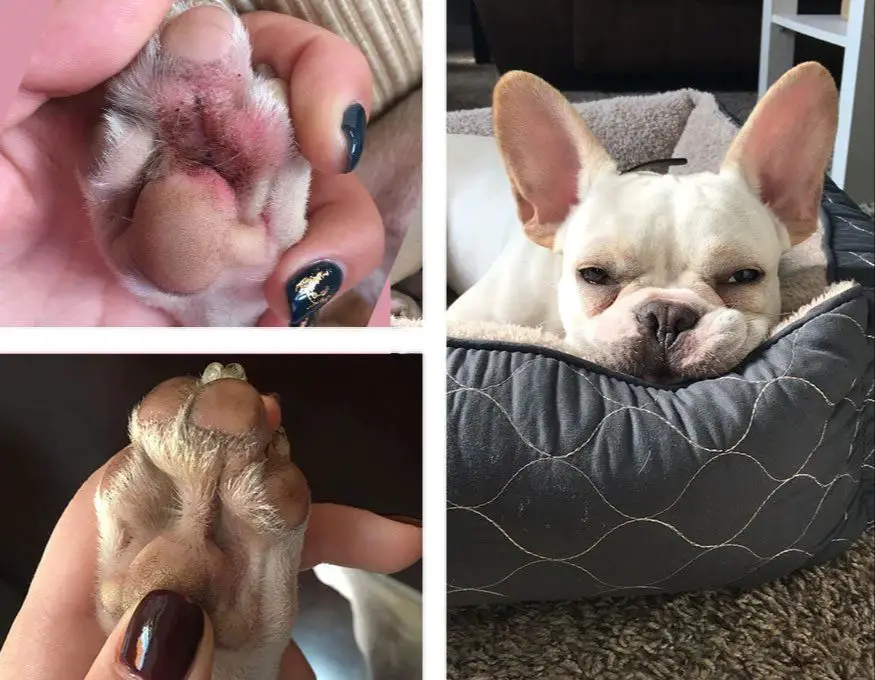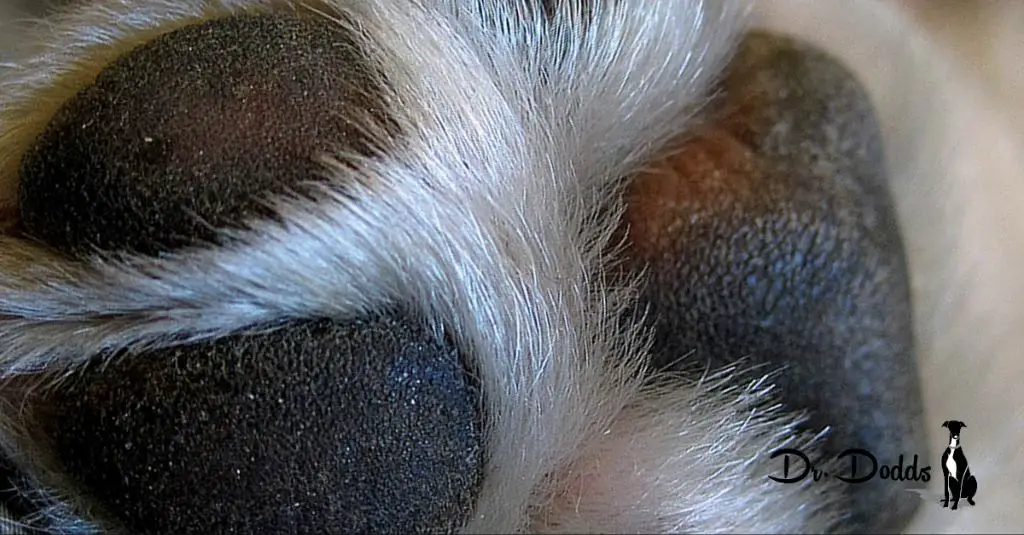What Causes Soreness Between Dog Toes?
There are several potential causes of soreness between a dog’s toes:
Friction – Dogs that exercise on abrasive surfaces like concrete or asphalt can develop red, raw, and painful friction burns between their toes. The webbing between the toes is especially prone to chafing. Even short walks on rough terrain can cause soreness.
Allergies – Allergic reactions to food, grass, pollen or other substances can cause itchy, inflamed skin between the toes. The dog may lick and bite at their feet, causing further irritation. Moist discharge and redness develops.

Debris – Grass seeds, dirt, gravel or other debris trapped between the toes can be very irritating. As the dog walks, the foreign object rubs and presses into the soft webbing and causes inflammation or infection.
Infections – Bacterial or yeast infections often cause moist, smelly irritation between the toes. The infection thrives in the warm moist folds of skin, causing redness, itching, oozing and raw skin.
Trauma – Injuries like cuts, torn nails or laceration between the toes can cause soreness. The area often bleeds or weeps fluid until healed. Bruising may also occur, resulting in tender toes.
Signs of Irritation Between Toes
Some of the most common signs of irritation between your dog’s toes include excessive licking, chewing, redness, swelling, limping, and signs of pain or discomfort. Here are some details on what to look out for:
Licking and chewing: Dogs will often lick and chew at their paws if they have soreness between the toes. Excessive licking and chewing focused on the paws is not normal behavior and may indicate an irritation or infection between the toes. Pay attention to any persistent licking, chewing, or biting focused on the paw area.
Redness: Check the skin between your dog’s toes and look for any red, inflamed areas which can signify infection or allergy-related irritation. Redness between the toes is not normal and, combined with swelling, may indicate an underlying problem that requires treatment.
Swelling: If you notice puffiness, inflammation, or swelling between your dog’s toes or around the paw pads, this can be a sign of soreness from a skin condition or infection. Swelling between the toes often accompanies redness and needs to be addressed.
Limping: If your dog is limping or holding their paw up, only using three legs to walk, this points to pain likely caused by irritation between the toes. Limping warrants a veterinary visit to diagnose and treat the underlying issue.
Signs of pain: Some dogs may whimper, cry or excessively lick their paws if experiencing pain between the toes. Pay attention to behaviors that suggest your dog is uncomfortable or in pain, and inspect their paws for any problems.
Treatment Options
There are several treatment options for soreness between a dog’s toes to help soothe irritation and promote healing. Keeping the area clean is an important first step.

Gently wash between the toes with a mild soap and rinse thoroughly. Pat dry and apply a dog-safe topical ointment. Topical ointments with hydrocortisone, lidocaine, or pramoxine can help relieve itching and pain.
If a bacterial or yeast infection is suspected, an antibiotic or antifungal ointment may be recommended by your veterinarian. Apply as directed to the affected area between the toes.
In some cases, your vet may prescribe a steroidal or non-steroidal anti-inflammatory medication to reduce inflammation and discomfort. Follow dosage instructions carefully when giving your dog oral or topical medications.
Keeping the fur trimmed between the toes can also help improve air circulation and reduce moisture. Talk to your groomer or vet about proper trimming techniques.
With vet-approved treatment and keeping the area clean and dry, soreness between the toes should begin to improve within a few days. Seek prompt medical attention if there is no improvement or the condition worsens.
Preventing Soreness Between Toes
There are several steps dog owners can take to help prevent soreness and irritation between their dog’s toes:
Keep nails trimmed – Long nails can catch on carpeting or concrete, putting pressure on the paw pads and causing soreness. Keep your dog’s nails trimmed regularly to avoid issues.
Clean feet after walks – Dirt, debris, snow, ice, salt, and chemicals from roads and sidewalks can accumulate between your dog’s toes and lead to irritation. Gently wipe their paws with a damp cloth after walks.
Use paw balms – Balms or waxes provide a layer of protection against abrasive surfaces. Apply them before and after walks to moisturize pads and prevent cracking.
Avoid hot pavement – On hot sunny days, pavement and other surfaces can get hot enough to burn sensitive paw pads. Walk your dog early or late to avoid the hottest temperatures, or head for grassy areas.
Taking preventative steps can reduce the risk of sore, cracked, or irritated paws. Monitor your dog’s feet regularly and address any early signs of discomfort promptly.
When to See the Vet
In most cases, mild irritation and soreness between your dog’s toes will clear up on its own with simple at-home treatment. However, it’s important to contact your veterinarian if the soreness persists or worsens despite care at home.
Signs that warrant a trip to the vet include:
- Persistent lameness or limping
- Swelling between the toes or foot pad
- Redness, bleeding, or oozing from between the toes
- Loss of fur between the toes
- Unusual odor coming from the paws
- Licking, biting or chewing at the paws
These signs could indicate a deeper infection or allergy that requires medication. Your vet can properly diagnose the cause and prescribe antibiotics, antifungals, or steroid creams as needed. Leaving these issues untreated allows them to worsen and spread.
It’s also important to see the vet if your dog is limping consistently or crying in pain. Persistent lameness indicates injury or inflammation requiring professional care. Don’t delay – getting treatment quickly will help prevent long-term complications.
Allergies Causing Paw Soreness
Allergies are a common cause of inflammation and irritation between dog toes. Dogs can develop allergies to foods, medications, pollens, molds, dust mites, and other environmental allergens. These allergies can cause itching, redness, and soreness between the toes.

Food allergies often result in itchy skin and feet. Common food allergens for dogs include beef, dairy, chicken, lamb, fish, eggs, corn, wheat, and soy. A dog with a food allergy may lick and bite at their paws constantly. Switching to a hydrolyzed protein diet prescribed by a veterinarian is the most effective treatment.
Environmental allergies to things like pollen and dust mites typically cause itchy skin and feet during certain seasons when the allergens are high. Dogs may lick and chew their paws relentlessly. Allergy testing and medications can provide relief from environmental allergies.
Symptoms of allergies affecting the paws include redness between the toes, swelling of the paws, hair loss around the paws, moist dermatitis, bacterial or yeast infections, and excessive licking, biting and chewing at the paws. Keeping the fur trimmed short can help minimize irritation. Antibiotics or antifungal medications may be needed to clear up secondary infections.
Yeast and Bacterial Infections
Yeast and bacteria naturally occur on a dog’s paws, but overgrowth can lead to infection between the toes. Moist, dark environments allow microbes to thrive. Common causes include:
- Excess moisture – From damp grass, rain, baths, swimming, or licking between toes
- Allergies – Causing incessant paw licking that damages skin
- Warm weather – Promotes bacterial and fungal overgrowth
- Fold infections – Deep wrinkles and folds between breeds like Bulldogs trap moisture and microbes
Signs of a yeast or bacterial infection between the toes include:
- Redness
- Swelling
- Itching
- Chewing/licking at paws
- Greasy residue between toes
- Odor
- Hair loss
Treatment involves topical and/or oral antifungal or antibiotic medication, prescribed by a vet based on a culture. Keeping the paws clean and dry is key. In severe cases, antibiotic baths or antifungal shampoos may be needed.
Other Medical Causes of Soreness Between Dog Toes
In some cases, soreness between a dog’s toes can be caused by more serious medical conditions that require veterinary diagnosis and treatment. Some possibilities include:
Arthritis
Osteoarthritis is common in older dogs and can result in joint inflammation and pain. The joints in the toes can be affected. Arthritic pain between the toes may cause a dog to lick and bite at their feet.
Autoimmune Diseases
Autoimmune conditions like lupus can cause painful inflammation and sores on a dog’s paws and between their toes. This is due to abnormal immune system attacks on the tissue.
Tumors
Cancerous and non-cancerous tumors sometimes develop between a dog’s toes. These growths can ulcerate and become painful. Tumors require diagnosis and treatment from a veterinarian.
If a dog has soreness between their toes along with other symptoms like limping or swelling, it’s important to have them examined by a vet. An underlying condition may be the cause. Proper treatment can provide relief and prevent progression of medical issues like arthritis, autoimmune disease, or cancer.
At-Home Care Tips
There are several things you can do at home to help soothe soreness between your dog’s toes and promote healing:
Soaks

Soaking your dog’s paws in a warm Epsom salt or chamomile tea bath can help reduce inflammation and clean the area. Make sure the water is a comfortable temperature and soak for 5-10 minutes. Gently pat dry afterwards.
Cleaning
Use a pet-safe antibacterial wash or wipe to gently clean your dog’s paws, especially the areas between the toes. This helps remove debris, dirt, and microbes that could be causing or worsening the irritation. Rinse and dry thoroughly after cleaning.
Topicals
Applying a pet-safe topical ointment between the toes can provide soothing relief. Look for ointments containing colloidal oatmeal, aloe vera, vitamin E, or hydrocortisone. Apply a thin layer 2-3 times a day. This helps protect, hydrate, and reduce itching.
If symptoms persist or worsen despite home treatment, take your dog to the vet, as prescription medication may be needed.
When to Seek Specialist Care
In most cases, soreness between dog toes can be treated at home with careful cleaning, topical treatments, and prevention methods. However, if the irritation persists or worsens despite at-home care, it’s time to seek professional veterinary help.
See your vet if the soreness between the toes does not improve within a few days of home treatment. Recurring infections between the toes or paws are also a sign your dog may need prescription medications or medicated baths to fully clear up the problem.
For underlying conditions like allergies, endocrine disorders, or autoimmune diseases causing chronic paw issues, a veterinary specialist can help diagnose the root cause and recommend the best long-term treatment plan.
In severe cases with excessive swelling, bleeding, or oozing between the toes, urgent veterinary care is advised. These symptoms can suggest a deeper infection or injury needing immediate treatment.
While mild irritation between dog toes can often be handled at home, recurrent or worsening soreness warrants an expert eye. Partnering with your veterinarian and specialists ensures your dog’s paws stay healthy inside and out.